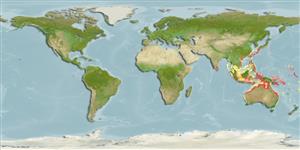>
Carangaria/misc (Various families in series Carangaria) >
Leptobramidae (Beachsalmon)
Etymology: Leptobrama: Greek, leptos = thin + old French breme, bresme, a fresh water fish; 1460 (Ref. 45335).
More on author: Steindachner.
Environment: milieu / climate zone / depth range / distribution range
Ecologia
marinhas; Água doce; estuarina pelágico(a,os,as). Tropical
Indo-West Pacific: northern Australia.
Tamanho / Peso / Idade
Maturity: Lm ? range ? - ? cm
Max length : 37.5 cm SL macho/indeterminado; (Ref. 30691)
Descrição suscinta
Morfologia | Morfometria
Vértebras: 24. This species is distinguished by the following set of characters: head length 21.7-22.7 % SL, snout length 19.9-24.5 % HL, upper jaw length 53.0-61.3 % HL, snout length 35.6-43.4% of upper jaw length; total gill rakers 13-18; scale rows below lateral line 13-14; vomerine tooth patch is rhomboid; tip of pectoral fin is almost same level as tip of appressed pelvic fin; lateral line gradually curved anteriorly. Colouration: a prominent black spot distally on anterior dorsal fin, with its size almost same as eye diameter or larger (Ref. 129587).
This species is apparently living inshore and migrating into brackish water as the specimens used in this study were collected from the lower reaches of rivers, estuaries or inner part of bays (Ref. 129587).
Ciclo de vida ou comportamento de acasalamento
Maturidade | Reprodução | Desova | Ovos | Fecundidade | Larvas
Kimura, S., T. Peristiwady and R. Fricke, 2016. Taxonomic review of the genus Leptobrama Steindachner 1878 (Perciformes: Leptobramidae), with the resurrection of Leptobrama pectoralis (Ramsay and Ogilby 1887). Ichthyol. Res. 63:435-444. (Ref. 129587)
Status na Lista Vermelha da UICN (Ref. 130435)
Ameaça para os humanos
Harmless
Uso pelos humanos
Mais informação
Nomes comunsSinônimosMetabolismoPredadoresEcotoxicologiaReproduçãoMaturidadeDesovaAgregação de desovaFecundidadeOvosDesenvolvimento dos ovos
Idade/TamanhoCrescimentoPeso-comprimentoComprimento-comprimentoFrequências de comprimentoMorfometriaMorfologiaLarvasDinâmica larvalRecrutamentoAbundânciaBRUVS
ReferênciasAquaculturaPerfil para aquaculturaEstirpesGenéticaElectrophoresesHereditariedadeDoençasProcessamentoNutrientsConversão de massa
ColaboradoresFotosStamps, Coins Misc.SonsCiguateraVelocidadeTipo de nataçãoÁrea branquialOtólitosCérebrosVisão
Ferramentas
Relatórios especiais
Baixar XML
Fontes da internet
Estimates based on models
Preferred temperature (Ref.
123201): 24.1 - 28.9, mean 27.7 °C (based on 544 cells).
Índice de diversidade filogenética (Ref.
82804): PD
50 = 1.5000 [Uniqueness, from 0.5 = low to 2.0 = high].
Bayesian length-weight: a=0.01122 (0.00514 - 0.02450), b=3.04 (2.87 - 3.21), in cm total length, based on all LWR estimates for this body shape (Ref.
93245).
Nível Trófico (Ref.
69278): 4.5 ±0.8 se; based on diet studies.
Fishing Vulnerability (Ref.
59153): Moderate vulnerability (36 of 100).
